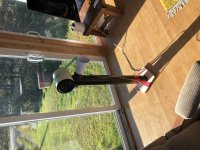1) right angle acoustic suspension / air compliance
2) cardioid u-baffle full range
3) fun w paper horns
2) cardioid u-baffle full range
3) fun w paper horns
Attachments
Last edited:
Looking at that gave me a thought - If you're port is made in a trumpet or horn shape (as in the picture) Would this increase output, the same way it would if you shout through a horn? Or maybe it wouldn't work because the wavelengths are too long or something?
I guess it wouldn't work, or we would see it in commercial designs.
I guess it wouldn't work, or we would see it in commercial designs.
My first impression is that the right angle acoustic suspension ‘works’ as acoustic suspension but I seem to have a lot a resonance issues from 200hz+. It’s maybe 1/2 full of fibreglass insulation and it’s hard to stuff it completely - or even to experiment w the stuffing. So I need to cross at 300 which means the 2” full range runs non linear pretty quickly - which is kinda lame.
The rear u-baffle tube on the full range seems promising. It doesn’t take much stuffing to damp the resonances and i think that means some kind of variable/adjustable low pass filtering of the rearward radiation based on stuffing. Maybe it can make nice cardioids? It’s too windy atm to make measurements.
The horn lolz. I don’t know much about horn design (yet) but even that paper cone makes a substantial effect on the 250hz+ full range radiation. I was just trying to get a sense of the controlled radiation ‘feeling’.
It’s not a port - it’s a two way implementation. I was seeing if I can get it image like my Pluto implementation. W/o the horn (lolz) I can still get the 3D holographic imaging even at 250Hz or so. It still works best 3’+ from the rear wall - I think - unfortunately. Basically it’s a Pluto like implementation that has no obvious advantages. Although I think the cardioid mid/full range might have some potential.
The rear u-baffle tube on the full range seems promising. It doesn’t take much stuffing to damp the resonances and i think that means some kind of variable/adjustable low pass filtering of the rearward radiation based on stuffing. Maybe it can make nice cardioids? It’s too windy atm to make measurements.
The horn lolz. I don’t know much about horn design (yet) but even that paper cone makes a substantial effect on the 250hz+ full range radiation. I was just trying to get a sense of the controlled radiation ‘feeling’.
It’s not a port - it’s a two way implementation. I was seeing if I can get it image like my Pluto implementation. W/o the horn (lolz) I can still get the 3D holographic imaging even at 250Hz or so. It still works best 3’+ from the rear wall - I think - unfortunately. Basically it’s a Pluto like implementation that has no obvious advantages. Although I think the cardioid mid/full range might have some potential.
Last edited:
